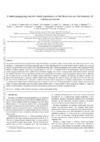Identificador persistente para citar o vincular este elemento:
https://accedacris.ulpgc.es/jspui/handle/10553/35732
| Título: | Counter-propagating radiative shock experiments on the Orion laser and the formation of radiative precursors | Autores/as: | Clayson, T. Suzuki-Vidal, F. Lebedev, S. V. Swadling, G.F. Stehlé, C. Burdiak, G. Foster, J.M. Skidmore, J. Graham, P. Gumbrell, E.T. Patankar, S. Spindloe, C. Chaulagain, U. Kozlova, M. Larour, J. Singh, R. L. Rodriguez, R. Gil, J. M. Espinosa Vivas, Guadalupe Velarde, P. Danson, C. |
Clasificación UNESCO: | 22 Física | Palabras clave: | Radiative shock Radiative precursor Counter propagating shocks |
Fecha de publicación: | 2017 | Publicación seriada: | High Energy Density Physics | Resumen: | We present results from new experiments to study the dynamics of radiative shocks, reverse shocks and radiative precursors. Laser ablation of a solid piston by the Orion high-power laser at AWE Aldermaston UK was used to drive radiative shocks into a gas cell initially pressurised between 0.1 and 1.0 bar with different noble gases. Shocks propagated at 80 +/- 10 km/s and experienced strong radiative cooling resulting in post-shock compressions of x25 +/- 2. A combination of X-ray backlighting, optical self-emission streak imaging and interferometry (multi-frame and streak imaging) were used to simultaneously study both the shock front and the radiative precursor. These experiments present a new configuration to produce counter-propagating radiative shocks, allowing for the study of reverse shocks and providing a unique platform for numerical validation. In addition, the radiative shocks were able to expand freely into a large gas volume without being confined by the walls of the gas cell. This allows for 3-D effects of the shocks to be studied which, in principle, could lead to a more direct comparison to astrophysical phenomena. By maintaining a constant mass density between different gas fills the shocks evolved with similar hydrodynamics but the radiative precursor was found to extend significantly further in higher atomic number gases (similar to 4 times further in xenon than neon). Finally, 1-D and 2-D radiative-hydrodynamic simulations are presented showing good agreement with the experimental data. | URI: | https://accedacris.ulpgc.es/handle/10553/35732 | ISSN: | 1574-1818 | DOI: | 10.1016/j.hedp.2017.03.002 | Fuente: | High Energy Density Physics [ISSN 1574-1818], v. 23, p. 60-72 |
| Colección: | Artículos |
Citas SCOPUSTM
10
actualizado el 08-jun-2025
Citas de WEB OF SCIENCETM
Citations
10
actualizado el 08-jun-2025
Visitas
95
actualizado el 27-ene-2024
Descargas
87
actualizado el 27-ene-2024
Google ScholarTM
Verifica
Altmetric
Comparte
Exporta metadatos
Los elementos en ULPGC accedaCRIS están protegidos por derechos de autor con todos los derechos reservados, a menos que se indique lo contrario.
